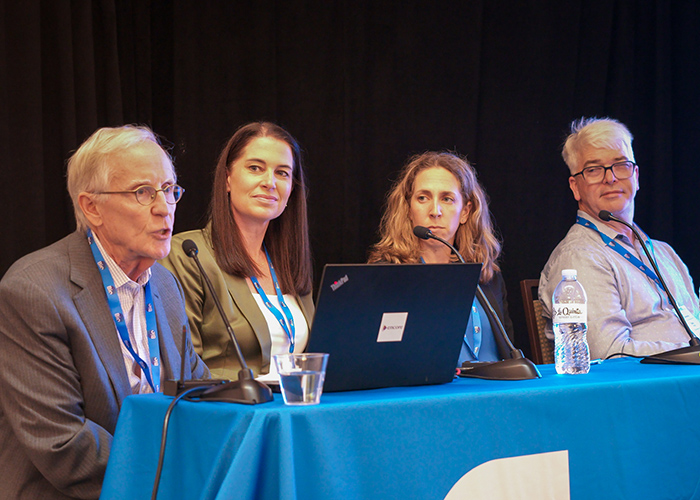The U.S. biotech sector is a vital economic engine in all 50 states, providing 2.1 million jobs and a $2.9 trillion impact on the economy in 2021, according to a comprehensive report published today.
The report, produced by the Biotechnology Innovation Organization (BIO) and the Council of State Bioscience Associations (CSBA) in partnership with TEConomy, gives extensive data on the U.S. bioscience industry, the country’s bioscience ecosystem and the sector’s growth on state and local levels. Based on federal statistics, it portrays a diverse and mature industry, with jobs averaging 85% above the mean private sector salary and a growing demand for workers.
Bioscience employers increased their payrolls by 11% in 2018-2021—a period when the private sector overall experienced a net jobs decline of 1.5%—the report says.
“The biotechnology sector is looking like one that has potential for explosive growth in the future and that’s a lot of what you see in the report,” says Nick Shipley, Executive VP and Chief Advocacy Officer at BIO. “This is where the growth is as an economy—the innovation economy.”
He adds that officials need to recognize the importance of the sector and enable its vital contribution to incomes, health, food supplies, the environment, and even national security.
“The TEConomy report released today by BIO and the Council of State Bioscience Associations (CSBA) highlights the vital role biotech plays in driving the U.S. economy forward,” notes Michele Oshman, VP of External Affairs at BIO and Executive Director of CSBA. “Our collective members bring critical innovations that aim to feed, fuel, and heal the world, and they employ 2.1 million people across all 50 states and Puerto Rico.”
A wide geographic spread
The report’s data on the broad geographical spread of the industry and its ecosystem is valuable for State Associations in the CSBA, who do the work of explaining to local officials why the industry deserves support, according to Peter Pellerito, BIO Senior Policy Adviser for State and Federal Economic Development and the editor of the report.
State and local officials are receptive to this information and incorporate the data into their development plans because they “have an instinctual understanding of the direct impact on economic development,” says Shipley. “I think you do see a very conscious recognition by a lot of states—probably more so than at the federal level—about how biotechnology and biomanufacturing connect to your state’s, your city’s economic development.”
States like California and Arizona are offering R&D tax breaks and other incentives, and county-level economic development plans now often include incentives to attract biotech firms and build clusters of biotech companies, Shipley notes.
According to Pellerito, the wider distribution of biotech is being accelerated by the ability to stay connected online. “The new reality is researchers don’t have to be in the same location as the corporate office,” he says. “I think the statistics show that the industry is spreading out all over the country.”
 Diverse range of work
Diverse range of work
As the locations of bioscience companies diversify, so do the types of work they undertake, such as agricultural biotech.
“Agricultural feedstock and industrial biosciences grew its employment base by 2 percent from 2018 to reach nearly 70,000 jobs, or 3 percent of all U.S. biosciences jobs,” according to the report. To cite a few local examples, the sector provides 5,557 jobs in Decatur, IL; 1,285 jobs in Baton Rouge, LA; and 1,005 jobs in Cedar Rapids.
Along with creating jobs, the work in agricultural biotech is essential to ensuring our food security, sustainability, and even price stability, Shipley notes.
“It’s not just the security piece of the supply chain, it’s also on the access side of it—the inflation spikes that we see when you go to the grocery store,” he says. “There is this desire to explore biobased solutions in that space.”
In addition to providing food security, agricultural biotech also provides solutions for climate change, such as biofuels and carbon capture.
“I think as people have looked for solutions to sustainability problems, they are coming to grips with the idea that there’s going to be a single magic bullet,” says Shipley. “You’ve got to have a more robust suite of solutions, and it’s going to involve innovation and technology in the biologic space.”
Investment is booming
Along with rapidly growing employment, the bioscience sector is experiencing a boom in investment, especially from venture capital (VC).
“More than $197 billion was invested in U.S. bioscience companies over the last four years, and both 2020 and 2021 saw truly impressive new highs reached in biosciences VC funding,” the report says. “Over the last decade, the bioscience industry’s average annual share of total U.S. VC funding has been 25 percent, and in the latest four-year period, this average has held.”
The interest from VC is driven by both an expanding range of possibilities in biotech and a greater sophistication among VC’s, according to Pellerito.
“The human genome project absolutely brought forward many, many opportunities in biology-based research and development for large molecules” produced through biologics, Pellerito says.
Meanwhile, with an appreciation for the growing complexity of the field, VC firms have hired biochemists to help them better understand the technology and its possibilities, he adds. The result is more sophisticated investors.
“Basically, they’re smarter than they were before,” Pellerito explains. “They’re bringing on people who are incredibly sophisticated at understanding the complexity of a protein and how it interacts with other proteins, to potentially create a therapeutic.”
Calling for an appropriate policy response
Officials need to recognize the current importance and huge potential of biotech for the economy, according Shipley. “The way they talk about jobs on the campaign trail—automakers, family farmers, coal miners. Nothing against any of those jobs, but there are simply more of these biotech jobs now,” he says. “The world has changed, moved forward, and this is a real growth area.”
The Biden administration may have begun to recognize this, recently, Shipley says. “You have seen this administration, just like in the last month, really pivot in how they talk about this sector,” as they mention its importance for jobs and national security, he explains.
Shipley noted the recent Executive Order on Biomanufacturing is a positive development, although he stressed that any positive impact accruing from the order would be small compared to the harm to the industry caused by the price controls contained in the Inflation Reduction Act or the attack on IP embodied in support for a WTO TRIPS waiver for COVID-19 vaccines.
Still, he expressed the hope that the order represents “a potential philosophical shift,” which will translate into policies that support biotech, or at least reduce obstacles, so this robust, exciting sector can continue its impressive growth.






